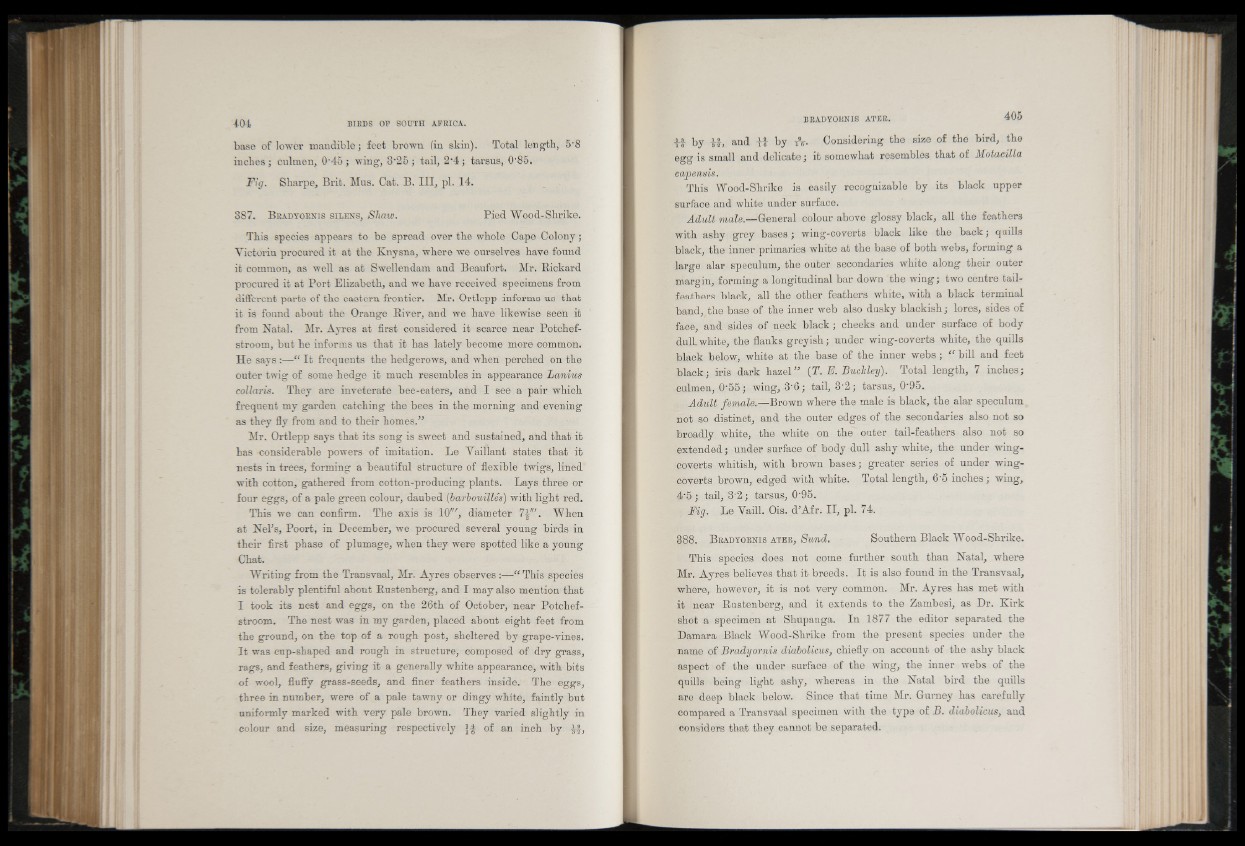
base of lower mandible; feet brown (in skin). Total length, 5‘8
inches; culmen, 0‘45; wing, 3*25; tail, 2‘4; tarsus, 0'85.
Fig. Sharpe, Brit. Mus. Cat. B. I ll, pi. 14.
387. B r a d y o e n i s s i r e n s , Shaw. Pied Wood-Shrike.
This species appears to be spread over the whole Cape Colony;
Victoriu procured it at the Knysna, where we ourselves have found
it common, as well as at Swellendam and Beaufort. Mr. Pickard
procured it at Port Elizabeth, and we have received specimens from
different parts of the eastern frontier. Mr. Ortlepp informs us that
it is found about the Orange River, and we have likewise seen it
from Natal. Mr. Ayres at first considered it scarce near Potchef-
stroom, but he informs us that it has lately become more common.
He says :—“ It frequents the hedgerows, and when perched on the
outer twig of some hedge it much resembles in appearance Lanius
collaris. They are inveterate bee-eaters, and I see a pair which
frequent my garden catching the bees in the morning and evening
as they fly from and to their homes.”
Mr. Ortlepp says that its song is sweet and sustained, and that it
has considerable powers of imitation. Le Vaillant states that it
nests in trees, forming a beautiful structure of flexible twigs, lined
with cotton, gathered from cotton-producing plants. Lays three or
four eggs, of a pale green colour, daubed (barbouilles) with light red.
This we can confirm. The axis is 10"/, diameter 7a"' . When
at Nel's, Poort, in December, we procured several young birds in
their first phase of plumage, when they were spotted like a young
Chat.
Writing from the Transvaal, Mr. Ayres observes :—“ This species
is tolerably plentiful about Rustenberg, and I may also mention that
I took its nest and eggs, on the 26th of October, near Potchef-
stroom. The nest was in my garden, placed about eight feet from
the ground, on the top of a rough post, sheltered by grape-vines.
I t was cup-shaped and rough in structure, composed of dry grass,
rags, and feathers, giving it a generally white appearance, with bits
of wool, fluffy grass-seeds, and finer feathers inside. The eggs,
three in number, were of a pale tawny or dingy white, faintly but
uniformly marked with very pale brown. They varied slightly in
colour and size, measuring respectively )■£ of an inch by if,
H by if , and H by * . Considering the size of the bird, the
©g>g ig small and delicate j it somewhat resembles that of Motct/dllci
capensis.
This Wood-Shrike is easily recognizable by its black upper
surface and white under surface.
Adult male.—General colour above glossy black, all the feathers
with ashy grey bases; wing-coverts black like the back; quills
black, the inner primaries white at the base of both webs, forming a
large alar speculum, the outer secondaries white along their outer
margin, forming a longitudinal bar down the wing; two centre tail-
feathers black, all the other feathers white, with a black terminal
band, the base of the inner web also dusky blackish; lores, sides of
face, and sides of neck black; cheeks and under surface of body
dull white, the flanks greyish; under wing-coverts white, the quills
black below, white at the base of the inner webs; “ bill and feet
black; iris dark hazel” (T. E. BuMey). Total length, 7 inches;
culmen, 0-55; wing, 3-6; tail, 3‘2; tarsus, 0-95.
Adult female.—Brown where the male is black, the alar speculum
not so distinct, and the outer edges of the secondaries also not so
broadly white, the white on the outer tail-feathers also not so
extended; under surface of body dull ashy white, the under wing-
coverts whitish, with brown bases; greater series of under wing-
coverts brown, edged with white. Total length, 6‘5 inches; wing,
4-5 ; tail, 32 ; tarsus, 0-95.
Fig. Le Vaill. Ois. d'Afr. II, pi. 74.
388. B r a d y o e n is a t e r , Sund. Southern Black Wood-Shrike.
This species does not come further south than Natal, where
Mr. Ayres believes that it breeds. It is also found in the Transvaal,
where, however, it is not very common. Mr. Ayres has met with
it near Rustenberg, and it extends to the Zambesi, as Dr. Kirk
shot a specimen at Shupanga. In 1877 the editor separated the
Damara Black Wood-Shrike from the present species under the
name of Bradyornis diabolicus, chiefly on account of the ashy black
aspect of the under surface of the wing, the inner webs of the
quills being light ashy, whereas in the Natal bird the quills
are deep black below. Since that time Mr. Gurney has carefully
compared a Transvaal specimen with the type of B. diabolicus} and
considers that they cannot be separated.